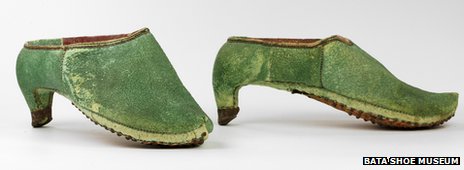
This week, the BBC suggested that high heels were originally a virile fashion for men, which followed on the 1599 Persian embassy to Europe. Elizabeth Semmelhack of the Bata Shoe Museum in Toronto was reported as saying that “the high heel was worn for centuries throughout the near east as a form of riding footwear … good horsemanship was essential to the fighting styles of Persia … when the soldier stood up in his stirrups, the heel helped him to secure his stance so that he could shoot his bow and arrow more effectively.”
The BBC included the pic above of these very cute shagreen shoes. As it happened, I’d been checking out shagreen, having recently been to a fascinating lecture on the fish-skin version (click here to see manta shagreen on a Qing Japanese sword handle). Pincon – who travelled with Shirley in 1598 – wrote about how Qazvin was the best place to get shoes:
Qazvin is a little smaller than London … but it is very badly built in baked brick … There is nothing remarkable except a few mosques and the doorway of the palace of the King, which is well built. There are a great many merchants, but not many rich ones, also several artisans such as goldsmiths and cobblers, who make the best shoes in the country out of segrin [shagreen], in green, white and other colours.
Heels definitely sound a good idea for horse-riding. But when I thought about what the BBC had written, I wasn’t sure. I’m definitely not a Persian shoe expert – but click here to see some horsemen with no heels. And there is only one in this painting of Shah Abbas hunting in Radkan: zoom on the left hand image to see no heel-shoes, and on the right (bottom right corner) for someone who’s maybe got a heel.
If you know more, please do share!
High heels were pretty popular during the Safavid era:
http://www.akdn.org/museum/detail.asp?artifactid=1103